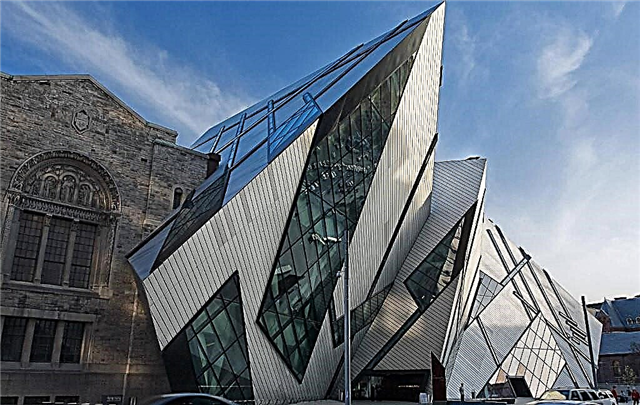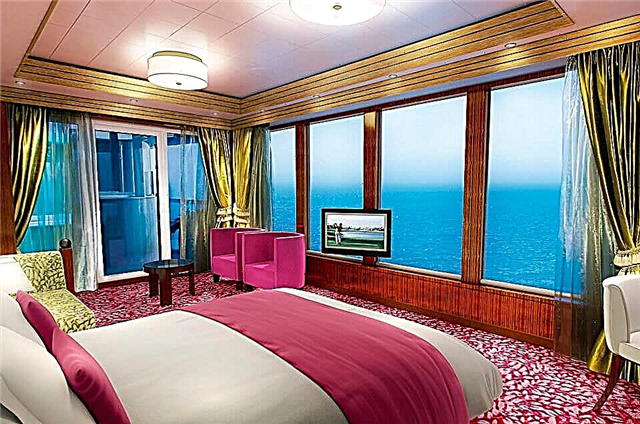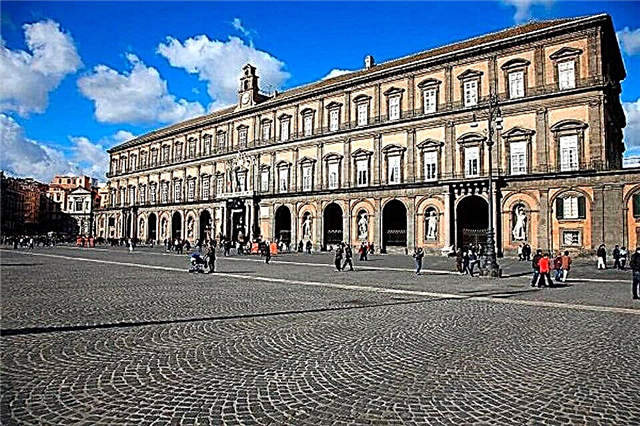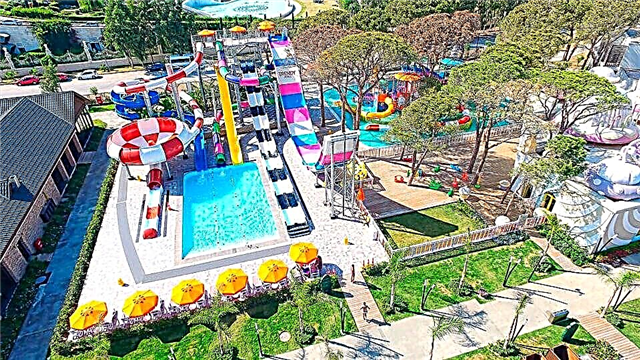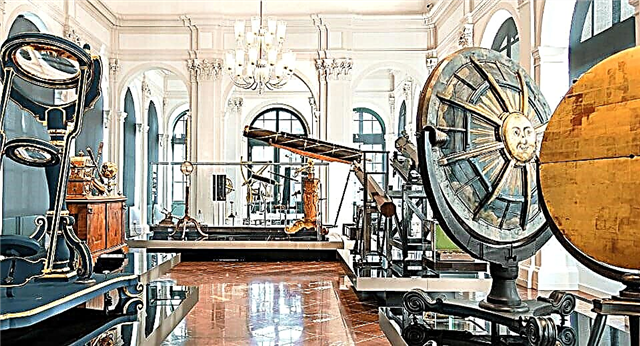One of the most beautiful cities in Germany is unofficially called Florence on the Elbe. In terms of the number of architectural attractions, cultural and historical monuments and museums, Dresden is not inferior to the famous Florence. This unique city has literally risen from the ashes of war destruction to become the center of European art. Dresden's numerous Museums, carefully restored after the war, leave an unforgettable experience.
Military History Museum

This incredibly interesting museum institution boggles the imagination even with its appearance. The classic building of the arsenal (1887), in which it is based, is, as it were, dissected by a huge metal wedge. It symbolizes the destruction caused by the bombing (its tip is aimed at the site of the targeting devices for shelling). The content of the exhibitions covering the periods from 1300 to the present is also interesting and captivating.
More than 10 thousand exhibits are presented here, located on 13 thousand square meters. m. Equipment of different types of troops, all kinds of weapons, models of ships and submarines, archival documents and photos reflect the 7-century history of military battles. A lot of new things can be learned by studying thematic stands about the specific features of war and its connection with various spheres of society.
Free excursions for tourists are held on the following days: Monday - Friday (except Wednesday) at 14.00; Sat. - 11.00, 12.00, 14.00; Sun - 11.00, 12.00, 14.00, 15.00.
Dresden City Museum

Among its brethren, the Dresden City Museum is the largest and most important in terms of importance. All sections of the city's development are presented in its expositions: history, art, everyday life, culture, science, music. Using 30 thousand exhibits, one can get a complete picture of the life and life of the townspeople in different eras, get acquainted with the life of prominent personalities of Dresden. Here are a lot of objects that have lost their use in everyday life. Collections of ancient musical instruments, clothes, weapons are amazing.
No one remains indifferent at the sight of children's toys, which were used even in knightly times. A lot of interesting things can be seen in the numismatics department - medals of various degrees, coins of the past, etc. The large-scale institution has a voluminous collection of scientific documents and a collection of inventions. Among them are valuable daguerreotypes, photographs, postcards with images of urban objects (late 19th century - 30s of the 20th century).
Opening hours: from 10.00 to 18.00 daily, except Monday.
Armouries

The collection of weapons, military armor, portraits of military leaders, ceremonial uniforms, kept in the Dresden Armory, has more than 10 thousand items. Of these, 2,200 items of cold steel and firearms. Sabers, swords, swords, daggers, pistols, revolvers, shotguns are on display. The first collector of weapons - Duke of Saxony Albrecht the Brave (1443-1500) At the end of his reign, all historical values, including weapons, were brought from different castles to Dresden. Weapon collection in the 19th century was kept in the Zwinger Palace and was opened for inspection.
After Hitler's defeat, some of the exhibits were taken to Leningrad and, after restoration, were exhibited in the Hermitage. In 1958 everything was returned to Dresden. Today, visitors see real masterpieces of the 16-18 century gunsmiths. - items of cold steel. There are magnificent examples of firearms (1.4 thousand pistols and 1.6 thousand rifles) Admiration is caused by items of clothing - dresses of medieval ladies embroidered with precious stones, knightly armor. On helmets, armor, chain mail, personal engravings are applied - a living history.
German Museum of Hygiene

The scientific and educational institution, created in 1912, was designed to acquaint the townspeople with the anatomical structure of a person, with the basics of hygiene and proper nutrition. The museum building is located on pl. Lingnerplatz, named after its founder, manufacturer and industrialist. In 1930, a new building was built for the opening of the 2nd International Exhibition on Hygiene Problems. At the same time, a unique exhibit "Glass Man" was created - an excellent tool for studying the anatomy of organs.
The bombing of 1945 did not pass by the museum building - it was badly destroyed, many exhibits were destroyed. Now the German Museum of Hygiene is very popular with children and adults. Schoolchildren visit the exhibition "Our Five Senses", learning the rules of hygiene, getting acquainted with the structure of the human body. Visitors have the opportunity to visually see the location and functional relationship of organs, get acquainted with modern medical devices. Exhibitions, seminars, conferences are held here.
Opening hours: Tuesday-Sunday. (Monday - day off), from 10.00 to 18.00.
Transport Museum

The most beautiful building in the neo-Renaissance style, which today represents various types of transport, has a rich history. In the 16th century. under Elector Christian I it served as a stable. Later, a second floor was erected on it with large arched windows and a grandiose front staircase, which became an architectural decoration. During the war years, railway vehicles from the Saxon Railway Museum were kept under the roof of the former stables. She served as the basis for the creation of a new museum transport institution (1956).
A huge number of exhibits - samples of various types of transport amazes the imagination and fully illustrates the history of the country's transport development. 6 permanent expositions introduce transport equipment for various purposes: cars, railway locomotives, wagons, horse-drawn and electric trams, airplanes, bicycles, motorcycles. Among them are genuine rarities - the first German steam locomotive "Muldenthal" (1861), a 3-wheeled retro car (1886), a glider (1894), the first truck (1927), etc.
Working hours: Tuesday-Sun, 10.00-18.00, Monday. - out-th.
Gallery of old masters

An art gallery with canvases by masters of the past is open in the beautiful Zwinger Palace. It is called the Gallery of Old Masters. The interiors are decorated without unnecessary fanfare, quite simple. The walls are painted in the same tone, there are low decorative panels at the bottom, and modest bas-reliefs under the ceiling. Everything is done so that nothing distracts visitors from contemplating the priceless masterpieces of the brush.
Paintings, hung in 2 rows, captivate the eye and imagination with ancient subjects, skill of the image and unfading colors. In the center of the halls there are cozy soft sofas where you can calmly relax without interrupting your inspection. In the basement of the building, the halls display the works of Italian painters from the 1st period of the Renaissance.
Canvases by Raphael, Botticelli, Tiepollo, Titian and other representatives of the 16-18 centuries. located on the 1st floor. Among the paintings is the famous "Sistine Madonna" by Raphael. There are the rooms of Rembrandt, Velazquez, Caravaggio, Van Dyck. 5 halls on the 2nd floor acquaint with paintings of the 18-19 centuries. The Gallery reflects all the directions of painting of the past, from classicism to rococo. They are captured in unique masterpieces by artists of different European nationalities.
Working hours: Tuesday-Sunday, from 10.00 to 19.00 (except Monday).
Porcelain Museum

Even those who are absolutely indifferent to porcelain will be fascinated by the “porcelain kingdom” located within the walls of the luxurious Zwinger Palace. The collection of products presented here is rightfully considered the most outstanding in the world in terms of the number of unique exhibits. Only here you can see rare examples of early Meissen and East Asian porcelain.
The beauty of products made of "white gold", the skill of painting, the harmony of colors make them perfect works of art, which must be admired.The beginning of the Dresden porcelain collection was laid by a passionate admirer of this precious fragile material, the Saxon Elector Augustus the Strong. He fanatically collected items of Chinese, Japanese, Meissen porcelain, and by 1721 there were more than 23 thousand of them. Now there are 12 thousand exhibits from the collection of that time.
Today, in the amazingly beautiful halls of the Zwinger, the best examples of products are presented (750 copies), and the entire collection consists of 20 thousand exhibits. One cannot indifferently pass by the porcelain items made during the reign of the Chinese emperors of the Ming dynasty (14-17 centuries) and Kangxi (17-18 centuries). Noteworthy is the collection of Japanese porcelain by the masters Imari and Kakimon (17-18 centuries). The exhibits of Meissen porcelain evoke admiration.
Open for visits: daily, except Mondays, 10.00-18.00.
Green vaults

The brilliance of diamonds, gold, silver and precious stones, the grace of sculptures, luxurious interior decorations - this is the richest treasury of Europe "Green Vaults". The exhibits displayed here showcase the financial well-being of the Wettin royal dynasty. Lots of jewelry, magnificent dishes, interior items, portraits delight in their appearance and skill of execution. The collection contains over 4 thousand exhibits.
The famous Dresden treasury is housed in a former palace residence, the beauty of which is not inferior to the collection stored here. The treasury is named after the chic columns of green malachite (now decorated with mirrors) and the huge green diamond stored here. The exhibitions are divided into thematic zones: Historical Green Vaults and New Green Vaults.
The Jewelry Room of August the Strong contains exclusive jewelry with diamonds, rubies, diamonds and the world's largest sapphire of 548 carats. The same exclusive is the sculpture of the Moor, carved from pear wood and decorated with many precious stones. The Golden Bowl of Ivan the Terrible, inlaid with pearls and sapphires, is a gift from Peter I. Each exhibit of the Green Vaults is a true work of art that gives aesthetic pleasure.
Zwinger

The pride of Dresden, an architectural gem and the main decoration of the city - the Zwinger palace and park complex was erected under Augustus the Strong. Four magnificent buildings form an inner courtyard square with fountains and flower beds. The palaces built of yellow sandstone in the Baroque style are real architectural masterpieces of the famous architect Peppelman (1732). The 4th building in a more austere style appeared later (now it houses an art gallery).
Dozens of antique sculptures, stucco ornaments, arched vaults, openwork lattices, and other decorative elements create a uniquely beautiful appearance of palaces. The main decoration is a giant gilded crown crowning the main portal. The luxurious halls today house royal treasures, collections of weapons, picturesque works of art.
An important symbol of the Zwinger is the Crown Gate, embodying the splendor of the Baroque, decorated with sculptures of ancient gods and crowned with a "crown". The famous building of the complex is the Pavilion of Wanderings, with rows of columns, arched windows and statues. Here is a sculpture of Augustus, depicted as a mythological Hercules with a globe on his shoulders. Visitors are delighted with the ringing of 40 bells in the Bell Pavilion. Inspection of the Zwinger - immersion in the Beautiful!
Opening hours: every day, except Tuesday, from 10.00 to 18.00.
Albertinum

Named after the Saxon King Albert, this imposing 19th century building is a repository of art from different eras. After the destruction of the war, the Albertinum was rebuilt in 1953. A severe flood in 2002 caused significant damage, so it became necessary to reconstruct the storage facilities. In 4 years, the building of the New Albertinum was built, the courtyard of which is called the "Ark of Art".
The glass walls of the renovated institution are able to withstand any flood. A 2-storey annex was erected above the courtyard, where the storage facility and restoration workshops were located. In the atrium of the courtyard, there are cafes, shops and entrances to exhibition halls. It is planned to hold music concerts and ballet performances here.
The entrance hall is decorated with antique sculptures, baroque sculpture of Chronos and a modern statue of "Egyptian" Rukrim. This is the credo of the Albertinum institution - to carry out the connection of times in art. Therefore, in the Sculptural Hall "The Thinker" Rodin is adjacent to "Ruins" and the installation "Catcher of Souls" by contemporary artists Scheibitz and Dickers. In general, contemporary works of German art can be found in the Gallery of New Masters.
Opening hours: daily, except Mondays, from 10.00 to 18.00.
Zoo museum

In a quiet corner of the picturesque surroundings of Dresden, there is the Zoological Museum, which is part of the city's State Natural Science Collection. It is the oldest institution of its kind in Europe, opened in 1728. By order of August II, one of the Zwinger buildings was provided for the new collection. The first exhibits were finds from the 16th century, collected by the elector for the Kunstkamera.
After the famous fire in the Zwinger, they were practically destroyed. The director of the museum, Reichenbach, spent 6 years restoring the collection, and in 1857 the exhibitions were reopened to the public. When in 1874 the renowned anthropologist and ethnographer Meyer became the head of the museum, he classified all objects by their importance.
3 sections introduce visitors to vertebrates, insects and invertebrates. 3 departments: preparative, molecular genetic laboratory and library - carry out research activities. 6 million exhibits: vertebrates (231 thousand specimens), insects (only 2.5 million beetles) and many unique objects are presented in the expositions of a very interesting natural history institution.
Opening hours: daily (except Mondays), from 10.00 to 18.00.
Ethnographical museum

In the central district of Dresden in a wonderful garden with red gravel paths, with a beautiful landscape, there is an unusual building in the Japanese style "Japanese Palace". This worthy architectural monument of the 18th century houses the Dresden Museum of Ethnography. With the light hand of the famous reformer in the field of culture, Elector Augustus, the beginnings of this institution appeared as early as 1560. August founded the "cabinet of curiosities", where interesting objects brought from different countries were collected as gifts.
The official opening of the Ethnographic Museum took place in 1954. Today, the museum fund contains almost 90 thousand items and 70 thousand photographs and documents. Perfectly designed expositions introduce the history, life and culture of the peoples of 5 continents: Australia and Oceania, Africa, Asia, America, Europe. The most unexpected and amazing exhibits illustrate the interesting traditions and way of life of the peoples of the world.
Open for visits: every day, except Mondays, 10.00-18.00.
Museum Panometer

The most original educational and entertainment facility in the city “Panometr” was opened in December 2006 in the building of the former gas storage. An amazing panoramic exposition was placed in it by the architect, Iranian of Austrian origin, Yadigar Azizi. In the 90s, he switched from architecture to creating panoramic paintings, having created "Ancient Rome 312" and 2 other panoramas in Leipzig.
Studying the Dresden panorama, Azizi attracted 10 historians, who for certain are reconstructing the appearance of the city in 1756. A documentary film shown in the "Panometer" tells about the painstaking work on the project. A panoramic view of Dresden of the Baroque era in architecture is captured on a huge (105 m long, 27 m high) canvas.Magnificent palaces, majestic churches, pompous villas on the Elbe embankment, beautiful gardens and flower beds seem to come to life before the eyes of the audience.
With the help of audio and video means, the impression of the reality of the spectacle is created. The dawn is reproduced with the sky glowing in the east, cock crows, birds chirping, horse stomping are heard. The coming night is also "drawn" with the evening bells ringing, stripes of moonlight. The lyrical music that sings at the heart accompanies the show. Here you can use special binoculars to "look into the windows" of Dresden residents. "Panometer" is a private museum institution.
Opening hours: Tuesday-Friday, from 9 am to 7 pm; Sat, Sun, holidays - 10.00-20.00.
ibis Dresden Zentrum
Dresden
10 minutes walk from the world famous Old Town Dresden

Holiday Inn Express Dresden City Center
Dresden
Located on the Altmarkt square

Star Inn Hotel Premium Dresden im Haus Altmarkt, by Quality
Dresden
Located on the Altmarkt square

Saxon Folk Museum

The fame of German punctuality, love of order and cleanliness has been known for a long time, but few people know about national folk art. You can fill this gap by visiting the Saxon Folk Museum. It is located in the historic building of Jägerhof - an architectural monument (17th century) Its expositions give a broad idea of the products of master carvers, ceramics, lacemakers, furniture makers, seamstresses, etc.
Among the 27 thousand exhibits, admiration is caused by the picturesque lace panel “800 years of Dresden, made with bobbins by virtuoso weaving masters. Each piece of handmade furniture surprises with the skill and quality of workmanship. Wrought iron, glass, metal and stone products are admired. The works of tailors and seamstresses, embroiderers and puppeteers are very interesting.
The unique collection of puppet theater is the largest in the world, it has 50 thousand copies from various countries of Europe and Asia. Puppet puppets, created in the 2nd century. back; hand-made theatrical, glove, fairground characters - eyes run up from their variety and quantity.
Opening hours: every day, except Mondays, 10.00-18.00.
Japanese palace

The history of this palace, built for the Dutch Earl of Flemming in 1715, also relates to Augustus the Strong. For several years the building was called the Dutch Palace, until the ubiquitous Elector became interested in it. He decided to make changes to the building in the form of a porcelain roof and porcelain interior decoration. The roof was redesigned in Japanese style, and the main façade was decorated with a bas-relief depicting Saxons and Japanese porcelain-making figures. The palace was renamed "Japanese".
After the death of the famous elector, the palace became a museum and library room where ordinary citizens could come. Like many dilapidated objects in Dresden, the Japanese Palace was restored from 1951 to 1986, returning it to its original appearance in 1737. All small details, wall paintings, external decorations were carefully restored so that new generations could admire the masterpiece of architecture.
Working hours: from 10.00 to 18.00, every day, except Mondays.
Museum of applied arts

In the former palace residence of the Saxon electors, Pilnitz, permanent exhibitions of works of applied art are held for visitors from May to the end of October. The idyllic landscapes surrounding the residence are no less enchanting than the beautiful buildings - "Palace by the Water" and "Mountain Palace". The vineyards and the picturesque banks of the Elbe are in themselves an attractive factor for tourists.
But the inner content of the palace halls also leaves no one indifferent. They exhibit items related to the life and life of Saxon rulers, princes and kings. They can be used to judge the splendor and luxury that surround a comfortable life, and the needs of those in power. One cannot help but be amazed at the elegant gilded throne, exclusive furniture made of silver or lacquered wood.
A lot of different dishes from Italian majolica, Delft faience, German ceramics, painted glass vessels are a kind of works of art. Samples of expensive exquisite fabrics are presented: damask, embroidered velvet and silk, delicious lace. In recent years, the collection has been replenished with works by contemporary designers from around the world.
Opening hours: from 30.04 to 01.11 daily, 10.00-18.00, Monday. - out-th.
Physics and Mathematics Salon

The fact that the scientific salon is located in one of the most magnificent palaces of the Zwinger testifies to the respectful attitude of the Dresden authorities to the exact sciences. The Physics and Mathematics Salon was founded under the ubiquitous Augustus the Strong (1728-1730). The shrewd Elector understood that technical progress was inconceivable without exact and natural sciences.
First, a museum of natural sciences and graphics was organized on the site of the greenhouse, which became the most significant institution of its kind in Europe. It exhibited minerals, shells, geological fossils, corals, amber, and contained scientific materials on anatomy, zoology, botany.
Today this institution is called the Physics and Mathematics Salon, which displays more than 1,000 exhibits - technical innovations from many eras. The huge collection of watches illustrates the development of these devices over the centuries. Various measuring devices are shown in chronological evolution: objects of optics, geodesy, astronomy, drawing and measuring instruments and fixtures.
Open for visits: daily, from 10.00 to 18.00, except Mondays.
GDR Museum

In the standard building of the Soviet period of the 70s, there are exhibits "telling" about the life of the Germans of Socialist Germany (GDR). The halls contain the largest collection of various objects, from the smallest attributes to dimensional structures, illustrating all spheres of state and social life.
This is not to say that this institution enjoys great attention of tourists, but it is undoubtedly very interesting to visit. Its expositions embody a historical era full of positive and negative, optimism and pessimism. Right at the entrance to the concrete-glass building, a Wartburq 311 car (1955-65) is parked in the eternal parking lot as a symbol of the automobile industry of the GDR.
Everything here is organized as in a quest: everyone can touch this or that object with their hands, listen to the TV show of that time in headphones. Those who wish can visit the cell, where they interrogated, for example, defectors and even "participate" in the elections. If desired, visitors open cabinets and drawers, examine their contents. A visit to a typical East German apartment, recreated down to the smallest detail, is very impressive. All that remains is to praise the people of Dresden for preserving a visual memory of the past.
Open for visits: Sun-Fri, 10.00-20.00, Sat. - 10.00-22.00.
Turkish chamber

The unique collection of weapons of the Ottoman Empire is famous throughout Europe for the number of exhibits and "age". Here are displayed specimens of weapons donated to the Elector of Saxony as early as the 16th century. Similar offerings were practiced in subsequent centuries, therefore, there are many such attributes of military significance. The Turkish Chamber is located in the residence palace, the interior of which is a harmonious background for its exhibits. The varieties of eastern weapons attract attention: sabers, swords, blades. There are many types of firearms, military banners, soldiers 'and officers' uniforms, horse harness with decorations, etc.
Opening hours: every day, except Tuesday, from 10.00 to 18.00.
Dresden Castle Residence

The magnificent decoration of the city is the medieval castle, which served as the residence of many Saxon rulers. The grandiose grandeur and baroque splendor, the grace of the Renaissance of the castle buildings amaze and delight. According to some reports, the first fortress appeared here at the end of the 12th century. This fact confirms the existence of a wooden bridge over the Elbe at that time, which was later replaced (1289) by a stone crossing.
Over the centuries, the "exterior" of the castle has changed in accordance with the architectural fashion and new styles. New forms of watchtowers, fashionable elements and designs were added, all kinds of decorations appeared. In the 15th century. buildings acquired Italian features, in the 16th century. erected new St. George's Gate (one of the highlights of the castle). Much has been rebuilt in the Renaissance style.
Today the palace-residence, which embodied in its external appearance a mixture of several architectural styles, is a clear example of the development of German architecture. An undoubted architectural masterpiece, which has acquired its present brilliant appearance as a result of improvements, pleases Dresden residents and tourists with its magnificent beauty.
Open for visits: daily, except Mondays, 10.00-18.00.


